Tsukemen
Tsukemen (Japanese: つけ麺, English: "dipping ramen")[1] is a ramen dish in Japanese cuisine consisting of noodles which are eaten after being dipped in a separate bowl of soup or broth. The dish was invented in 1961 by Kazuo Yamagishi, a restaurateur in Tokyo, Japan, after which it has become a very popular dish in Tokyo and throughout Japan. In the United States, tsukemen has become popular in Los Angeles, while it remains relatively uncommon in other American cities.
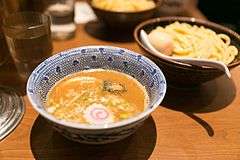 Tsukemen at a Tokyo restaurant | |
| Alternative names | Dipping ramen |
|---|---|
| Type | Noodle soup |
| Place of origin | Japan |
| Region or state | Tokyo |
| Main ingredients | Cold ramen noodles, broth |
Tsukemen is a Japanese noodle ramen dish in Japanese cuisine consisting of separate servings of noodles and soup or broth, whereby the noodles are dipped in the soup.[2][3] Soba and udon are some types of noodles used in the dish.[2][4][5] The noodles are typically served cold, while the soup is typically served hot, which serves to season and moisten the noodles.[2][3] The noodles can also be served at room temperature.[6] Additional ingredients used in the dish are typically served atop or on the side within the dish of noodles.[6] Some additional ingredients used include nori, chashu, menma, tamago and boiled eggs.[6][7]
The soup serves as a dipping sauce, and is typically much stronger and intense in flavor compared to standard ramen broth.[2][6] Dashi, a soup in Japanese cuisine, can be used,[2] which is prepared using a soup base or stock that is also named "dashi." Some restaurants add hot water to dilute the soup at the conclusion of the meal, decreasing its strength and making it more palatable as a soup to finish the meal.[2][8]
History
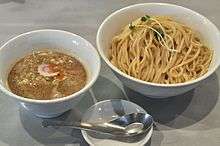
Tsukemen was invented in 1961 by Kazuo Yamagishi (1935–2015), who owned Taishoken restaurant, a well-known ramen restaurant in Tokyo, Japan.[2][9][10] In 1961, Yamagishi added the dish to his restaurant's fare using the name "special morisoba", which consisted of "cold soba noodles with soup for dipping."[9] At the time, it was priced at 40 yen, and the dish soon became very popular at Taishoken restaurants.[9][11] As of 2015, over 100 Taishoken restaurants exist in Japan.[9]
In recent years (circa 2000–present), tsukemen has become a very popular dish in Tokyo[5] and throughout Japan, and several restaurants now exist in the country that purvey it exclusively.[1][2][12][13]
Tsukemen is also served in restaurants in the United States[6] and in other countries. In recent years (circa 2013–present), Tsukemen has become a popular dish in some ramen shops in Los Angeles.[6] Conversely, in other areas of the U.S., such as Chicago, the dish is uncommon and rarely served in restaurants.[14]
Gallery
- Various tsukemen preparations
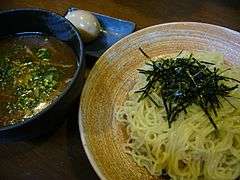 Tsukemen with nori-topped noodles
Tsukemen with nori-topped noodles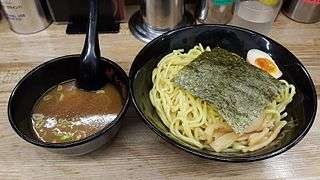 Tsukemen with a sheet of nori atop the noodles
Tsukemen with a sheet of nori atop the noodles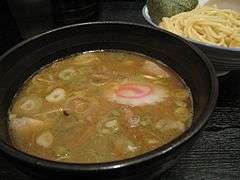 Close-up view of a soup for tsukemen
Close-up view of a soup for tsukemen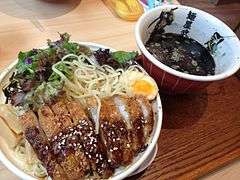 Tsukemen topped with fried pork cutlet, half of a soft-boiled egg and greens, in Singapore
Tsukemen topped with fried pork cutlet, half of a soft-boiled egg and greens, in Singapore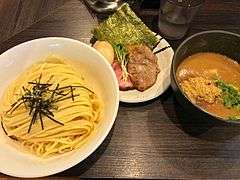 Tsukemen with additional foods on the side
Tsukemen with additional foods on the side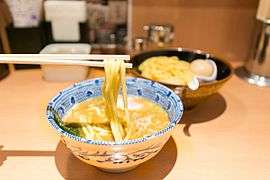 Tsukemen noodles being dipped
Tsukemen noodles being dipped
References
- Yagihashi, T.; Salat, H. (2011). Takashi's Noodles. Potter/TenSpeed/Harmony. p. 86. ISBN 978-1-60774-201-2.
- Orkin, I.; Ying, C. (2013). Ivan Ramen: Love, Obsession, and Recipes from Tokyo's Most Unlikely Noodle Joint. Ten Speed Press. p. 169. ISBN 978-1-60774-446-7.
- Kimoto-Kahn, A. (2016). Simply Ramen: A Complete Course in Preparing Ramen Meals at Home. Race Point Publishing. p. 117. ISBN 978-1-63106-144-8.
- Eaton, Hillary (October 28, 2015). "Watch Your Udon Noodles Being Made at Musashiya in Westwood, Opening Today". L.A. Weekly. Retrieved February 22, 2017.
- Time Out Tokyo. Time Out Guides. Time Out Guides. 2010. p. 157. ISBN 978-1-84670-121-4.
- Scattergood, Amy (July 31, 2013). "7 L.A. Ramen Shops for Great Bowls of Tsukemen". L.A. Weekly. Retrieved February 22, 2017.
- "Barikata dishes out new treats". Sun.Star Cebu. February 17, 2017. Retrieved February 22, 2017.
- Sietsema, Robert (August 7, 2011). "Dish No. 61: Pork Kimchee Tsukemen Soba at Cocoron". Village Voice. Retrieved February 22, 2017.
- "Ramen legend Kazuo Yamagishi passes away at 80". Japan Bullet. February 21, 2017. Retrieved February 22, 2017.
- Solt, G. (2014). The Untold History of Ramen: How Political Crisis in Japan Spawned a Global Food Craze. California Studies in Food and Culture. University of California Press. p. 161. ISBN 978-0-520-27756-4.
- "Death of a Noodle Master". NHK World. April 2, 2015. Archived from the original on April 21, 2017. Retrieved February 22, 2017.
- Dodd, J.; Richmond, S. (2011). The Rough Guide to Japan. Rough Guide to... Rough Guides. p. pt276. ISBN 978-1-4053-8926-6.
- Swinnerton, Robbie (July 6, 2012). "Rokurinsha: A ramen line-up worth dipping into". The Japan Times. Retrieved February 22, 2017.
- Dolinsky, Steve (October 28, 2016). "Tsukemen puts hot-and-cold twist on ramen". ABC7 Chicago. Retrieved February 22, 2017.
External links
| Wikimedia Commons has media related to Tsukemen. |